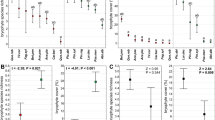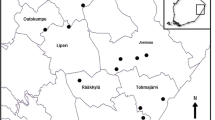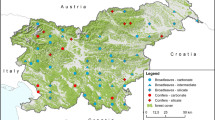Abstract
Bryophytes dominate the carbon and nitrogen cycling of many poorly drained terrestrial ecosystems and are important in the vegetation-atmosphere exchange of carbon and water, yet few studies have estimated their leaf area at the stand scale. This study quantified the bryophyte-specific leaf area (SLA) and leaf area index (LAI) in a group of different-aged boreal forest stands in well and poorly drained soils. Species-specific SLA (for three feather mosses, four Sphagnum spp. and Aulacomnium palustre mixed with Tomentypnum nitens) was assessed by determining the projected area using a flatbed scanner and cross-sectional geometry using a dissecting microscope. The hemisurface leaf area was computed as the product of SLA and live biomass and was scaled by coverage data collected at all stands. Pleurozium schreberi dominated the spatial coverage, biomass and leaf area in the well-drained stands, particularly the oldest, while S. fuscum and A. palustre were important in the poorly drained stands. Live moss biomass ranged from 47 to 230 g m−2 in the well-drained stands dominated by feather mosses and from 102 to 228 g m−2 in the poorly drained stands. Bryophyte SLA varied between 135 and 473 cm2 g−1, for A. palustre and S. capillifolium, respectively. SLA was strongly and significantly affected by bryophyte species, but did not vary between stands; in general, there was no significant difference between the SLA of non-Sphagnum mosses. Bryophyte LAI increased with stand age, peaking at 3.1 and 3.7 in the well and poorly drained stands, respectively; this represented approximately 40% of the overstory LAI in the well-drained stands and 100–1,000% in the poorly drained stands, underscoring the important role bryophytes play in the water and carbon budgets of these boreal forests.



Similar content being viewed by others
References
Bisbee KE, Gower ST, Norman JM, Nordheim EV (2001) Environmental controls on ground cover species composition and productivity in a boreal black spruce forest. Oecologia 129:261–270
Bonan GB (1993) Importance of leaf area index and forest type when estimating photosynthesis in boreal forests. Remote Sens Environ 43:303–314
Bond-Lamberty B, Wang C, Gower ST (2002a) Above- and belowground biomass and sapwood area allometric equations for six boreal tree species of northern Manitoba. Can J For Res 32:1441–1450
Bond-Lamberty B, Wang C, Gower ST (2002b) Leaf area dynamics of a boreal black spruce fire chronosequence. Tree Physiol 22:993–1001
Bond-Lamberty B, Wang C, Gower ST (2003) The use of multiple measurement techniques to refine estimates of conifer needle geometry. Can J For Res 33:101–105
Bond-Lamberty B, Wang C, Gower ST (2004) Net primary production and net ecosystem production of a boreal black spruce fire chronosequence. Global Change Biol 10:473–487
Camill P, Lynch JA, Clark JS, Adams JB, Jordan B (2001) Changes in biomass, aboveground net primary production, and peat accumulation following permafrost thaw in the boreal peatlands of Manitoba, Canada. Ecosystems 4:461–478
Campbell GS, Norman JM (1998) An introduction to environmental biophysics. Springer, Berlin Heidelberg New York
Chen JM, Rich PM, Gower ST, Norman JM, Plummer S (1997) Leaf area index of boreal forests: Theory, techniques, and measurements. J Geophys Res 102:29429–29443
DeLuca TH, Zackrisson O, Nilsson M-C, Sellstedt A (2002) Quantifying nitrogen-fixation in feather moss carpets of boreal forests. Nature 419:917–920
DeLucia EH et al (2003) The contribution of bryophytes to the carbon exchange for a temperate rainforest. Global Change Biol 9:1158–1170
Gehrke C (1998) Effects of enhanced UV-B radiation on production-related properties of a Sphagnum fuscum dominated subarctic bog. Funct Ecol 12:940–947
Gorham E (1991) Northern peatlands: role in the cabron cycle and probably responses to climate warming. Ecol Appl 1:182–195
Gower ST, Reich PB, Son Y (1993) Canopy dynamics and aboveground production of five tree species with different leaf longevities. Tree Physiol 12:327–345
Gower ST, Vogel JG, Norman JM, Kucharik CJ, Steele S, Stow TK (1997) Carbon distribution and aboveground net primary production in aspen, jack pine, and black spruce stands in Saskatchewan and Manitoba, Canada. J Geophys Res 102:29029–29041
Gower ST, Kucharik CJ, Norman JM (1999) Direct and indirect estimation of leaf area index, ƒAPAR and net primary production of terrestrial ecosystems. Remote Sens Environ 70:29–51
Green TGA, Lange OL (1994) Photosynthesis in poikilohydric plants: a comparison of lichens and bryophytes. In: Schulze E-D, Caldwell MM (eds) Ecophysiology of photosynthesis, vol 100. Springer, Berlin Heidelberg New York, pp 319–341
Halliwell DH, Apps MJ (1997) Boreal ecosystem-atmosphere study (BOREAS) Biometry and auxiliary sites: locations and descriptions. Forestry Canada, Northern Forestry Centre, Edmonton
Harden JW, O’Neill KP, Trumbore SE, Veldhuis H, Stocks BJ (1997) Moss and soil contributions to the annual net carbon flux of a maturing boreal forest. J Geophys Res 102:28805–28816
Hayward PM, Clymo RS (1983) The growth of Sphagnum: experiments on, and simulation of, some effects of light flux and water-table depth. J Ecol 71:845–863
Johnson D, Kershaw L, MacKinnon A, Pojar J (1995) Plants of the Western Boreal Forest & Aspen Parkland. Lone Pine Publishing, Edmonton
Lafleur PM, Rouse WR (1988) The influence of surface cover and climate on energy partitioning and evaporation in a subarctic wetland. Boundary-Layer Meteorol 44:327–347
Lambers H, Poorter H (1992) Inherent variation in growth rate between higher plants: A search for physiological causes and ecological consequences. Adv Ecol Res 23:187–261
Legendre P, Legendre L (1998) Numerical ecology, 2nd edn. Elsevier, Amsterdam
Longton RE (1992) The role of bryophytes and lichens in terrestrial ecosystems. In: Bates JW, Farmer AW (eds) Bryophytes and Lichens in a changing environment. Clarendon Press, Oxford, pp 32–76
Lugo AE, Brinson M, Brown S (eds) (1990) Forested Wetlands. Elsevier, Amsterdam
Matthews E, Fung IY (1987) Methane emission from natural wetlands: global distribution, area and environmental characteristics of sources. Global Biogeochem Cycles 1:61–86
O’Connell KEB, Gower ST, Norman JM (2003a) Comparison of net primary production and light-use dynamics of two boreal black spruce forest communities. Ecosystems 6:236–247
O’Connell KEB, Gower ST, Norman JM (2003b) Net ecosystem production of two contrasting boreal black spruce forest communities. Ecosystems 6:248–260
O’Neill KP (2000) Role of bryophyte-dominated ecosystems in the global carbon budget. In: Shaw AJ, Goffinet B (eds) Bryophyte biology. Cambridge University Press, Cambridge, UK, pp 344–368
Price AG, Dunham K, Carleton TJ, Band LE (1997) Variability of water fluxes through the black spruce (Picea mariana) canopy and feather moss (Pleurozium schreberi) carpet in the boreal forest of Northern Manitoba. J Hydrol 196:310–323
Proctor MCF (1980) Diffusion resistance in bryophytes. In: Grace J, Ford ED, Jarvis PG (eds) Plants and their atmospheric environment. Blackwell Scientific, Oxford, pp 219–229
Proctor MCF (2000) Physiological ecology. In: Shaw AJ, Goffinet B (eds) Bryophyte biology. Cambridge University Press, Cambridge pp 225–247
Proctor MCF, Tuba Z (2002) Poikilohydry and homoihydry: antithesis or spectrum of possibilities? New Phytol 156:327–349
Reich PB, Walters MB, Ellsworth DS (1992) Leaf life-span in relation to leaf, plant, and stand characteristics among diverse ecosystems. Ecol Monogr 62:365–392
Reich PB, Walters MB, Ellsworth DS (1997) From tropics to tundra: global convergence in plant functioning. Proc Natl Acad Sci 94:13730–13734
Rice SK, Schneider N (2004) Cushion size, surface roughness, and the control of water balance and carbon flux in the cushion moss Leucobryum glaucum (Leucobraceae). Am J Bot 91:1164–1172
Rice SK, Collins D, Anderson AM (2001) Functional significance of variation in bryophyte canopy structure. Am J Bot 88:1568–1576
SAS Institute Inc. (2001) SAS OnlineDoc® Version 8. In. Cary, NC
Schofield WB (2001) Introduction to bryology. The Blackburn Press, Caldwell
Shaw AJ, Goffinet B (eds) (2000) Bryophyte biology. Cambridge University Press, Cambridge
Shimoyama K, Hiyama T, Fukushima Y, Inoue G (2004) Controls on evapotranspiration in a west Siberian bog. J Geophys Res-Atmos 109:1–12
Tuba Z, Csintalan Z, Proctor MCF (1996) Photosynthetic responses of a moss, Tortula ruralis, ssp ruralis, and the lichens Cladonia convoluta and C-furcata to water deficit and short periods of desiccation, and their ecophysiological significance: A baseline study at present-day CO2 concentration. New Phytol 133:353–363
Turetsky MR (2003) The role of bryophytes in carbon and nitrogen cycling. Bryologist 106:395–409
Vitt DH, Halsey LA, Campbell C, Bayley SE, Thormann MN (2001) Spatial patterning of net primary production in wetlands of continental western Canada. Écoscience 8:499–505
Wang C, Bond-Lamberty B, Gower ST (2003) Carbon distribution of a well- and poorly-drained black spruce fire chronosequence. Global Change Biol 9:1–14
Whitehead D, Gower ST (2001) Photosynthesis and light-use efficiency by plants in a Canadian boreal forest ecosystem. Tree Physiol 21:925–929
Williams TG, Flanagan LB (1996) Effects of changes in water content on photosynthesis, transpiration and discrimination against 13CO2 and C18O16O in Pleurozium and Sphagnum. Oecologia 108:38–46
Williams TG, Flanagan LB (1998) Measuring and modeling environmental influences on photosynthetic gas exchange in Sphagnum and Pleurozium. Plant Cell Environ 21:555–564
Zotz G, Schweikert A, Jetz W, Westerman H (2000) Water relations and carbon gain are closely related to cushion size in the moss Grimmia pulvinata. New Phytol 148:59–67
Acknowledgments
This research was supported by grants from NASA (NAG5-8069) and the National Science Foundation (Integrated Research Challenges in Environmental Biology, DEB-0077881) to S. T. Gower. We thank Frank Santiago, Denise Smith and Glen Stanosz for their assistance in the field and lab and appreciate the thoughtful comments of two anonymous reviewers.
Author information
Authors and Affiliations
Corresponding author
Additional information
Communicated by Jim Ehleringer.
Rights and permissions
About this article
Cite this article
Bond-Lamberty, B., Gower, S.T. Estimation of stand-level leaf area for boreal bryophytes. Oecologia 151, 584–592 (2007). https://doi.org/10.1007/s00442-006-0619-5
Received:
Accepted:
Published:
Issue Date:
DOI: https://doi.org/10.1007/s00442-006-0619-5




